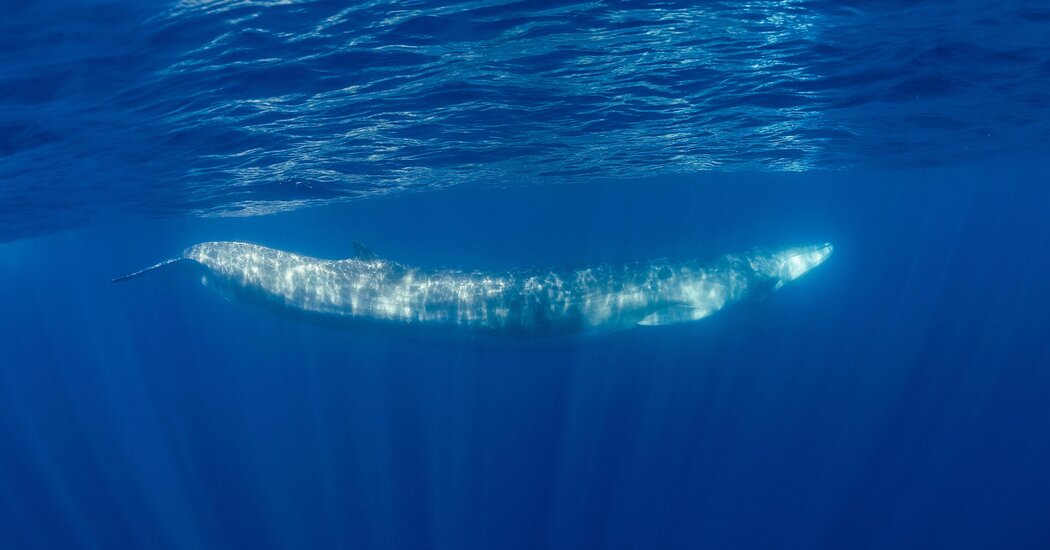In 2019, Václav Kuna, a seismologist, was perusing recordings from dozens of seismometers at the bottom of the northeast Pacific Ocean, when he kept finding strange noises: one-second chirps, repeating every 30 seconds or so.
This staccato symphony turned out to be the songs of fin whales.
“Because I’m a seismologist, I wasn’t just like, oh, fin whales, that’s cute,” said Dr. Kuna, then a doctoral student at Oregon State University.
Listen to fin whale chirps
He dove deeper into the data and found that these booming cetacean calls were impacting the seafloor. As they did, some of their energy transmitted through the ground as seismic waves, which bounced around the buried rocky expanse before being picked up by those ocean-bottom seismometers.
What Dr. Kuna, now at the Institute of Geophysics of the Czech Academy of Sciences, and John Nabelek of Oregon State would soon discover is that fin whale song can be used to peer into the oceanic crust. Using this biological source of seismicity, they found they could see 8,200 feet below the seafloor, through sediments and the underlying volcanic rock. There would be less need to wait for a tectonic source of seismic waves, or sending a fully crewed, air gun-armed ship into the middle of the ocean to create artificial seismicity and visualize the layer-cake nature of the planet’s underworlds.
“It’s a nice example of how we make use of the data the planet provides for us,” said Jackie Caplan-Auerbach, a seismologist and volcanologist at Western Washington University not involved with the work, which was published Thursday in Science.
Fin whales — 60-ton, 80-foot long, graceful beasts — get their name from the prominent fin on their backs. They are fast swimmers that love to eat krill, schools of tiny fish and squid. And as they swim in groups, they gossip with one another by making booming 189-decibel chirps.
“They’re really loud,” said William Wilcock, a marine geophysicist at the University of Washington who wasn’t involved with the work. “They’re nearly as loud as a big container ship.”
Usually, whale song inconveniences seismologists. Like static on a telephone line, it creates interference that can obfuscate earthquake seismicity, requiring scientists to filter it out.
“For some of us, it’s just been, ‘ugh, these dang whales are in my data,’” Dr. Caplan-Auerbach said. Humpback whales have interrupted her research in the past on Lō‘ihi Seamount, an underwater Hawaiian volcano. “We had tons and tons of whale song, and to me it was just total noise in my data.”
But as this new study shows, this noise can be used to study the planet’s interior. “And that’s awesome,” she said.
“It’s never going to replace air guns,” Dr. Kuna said. Fin whale seismic waves are somewhat weak, which means their imaging of the subsurface is of relatively low resolution. “But it is a complement. And it’s free.”
Although seismologists are careful to avoid marine life, a recent report detailed just how noisy the oceans have become in recent years as a result of human activity. Finding more ways to use fin whale seismology could mean adding less to the cacophony. “It’s win-win,” Dr. Kuna said.
For this study, the researchers had to determine the location of the fin whales, a bit like searching for the epicenter of an earthquake. They looked at the arrival times of both the whale chirps’ sound waves heading directly to the seismometer and the sound waves ricocheting between the sea surface and the seafloor. The time difference revealed the whale’s distance. Making some reasonable assumptions about the fin whale’s typical swimming depth, they could trace their journeys through the ocean.
This paper may be about the seismological benefits of fin whales, but this method may prove useful to marine ecologists, Dr. Wilcock said. In recent years, seismometers on land have been trying to track elephants and estimate their populations. The same principle could apply to fin whales, animals engendered by climate change, habitat loss and the grim legacy of commercial whaling. And like those elephant-eavesdropping seismometers, machine learning may one day listen for signature fin whale songs and autonomously detect different pods of fin whales, or individuals within those groups.
“We can use the tools of biology to study seismology,” Dr. Caplan-Auerbach said. “And we can use the tools of seismology to study biology.”
Source: Read Full Article
